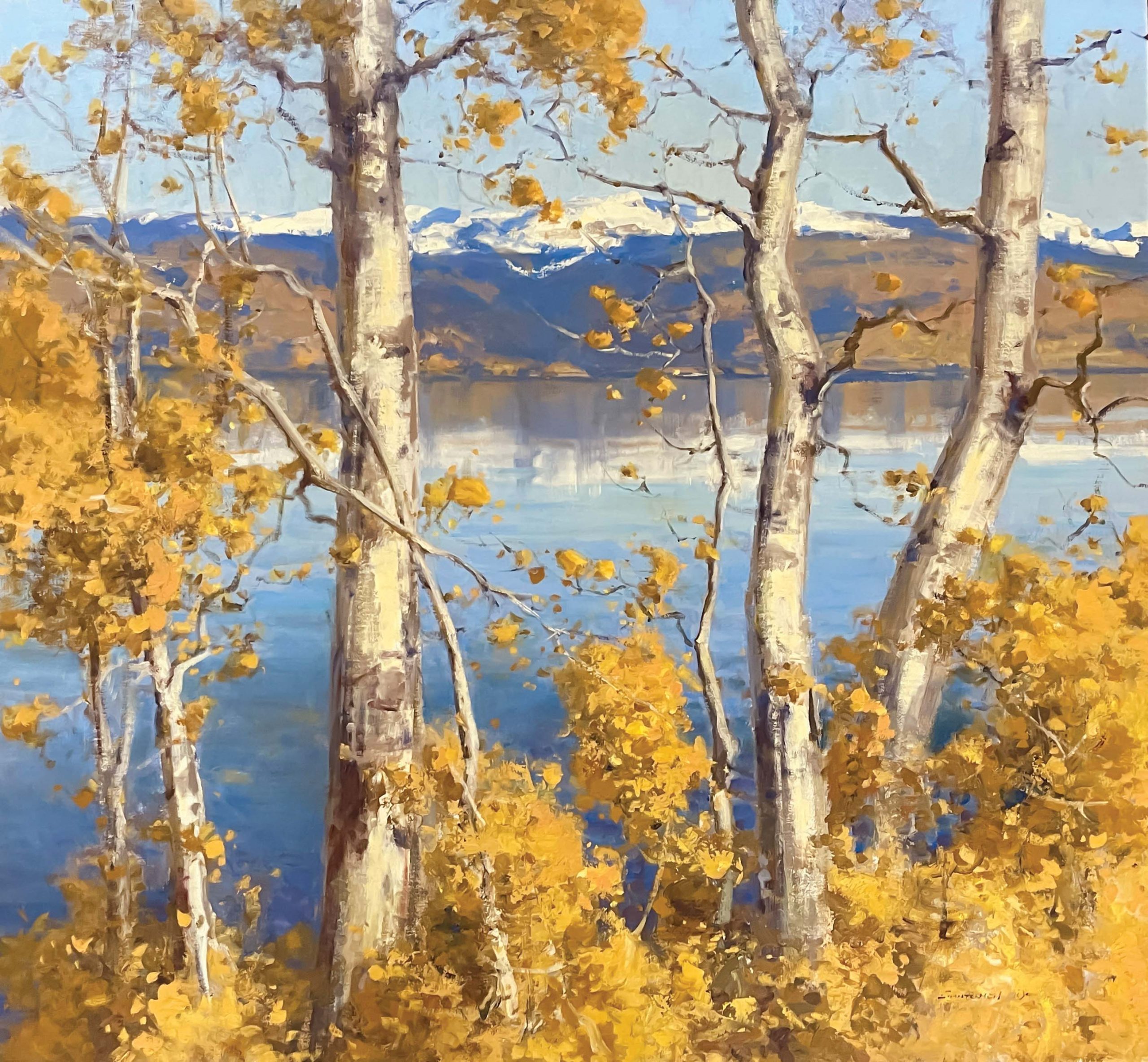
02 May Worlds Above and Within
Scott Christensen and Quang Ho both have close, personal relationships with the West, which is what the two artists have in common — this and the simple fact that they have spent their entire lives pushing pigment across once-white canvases.
The parallels between the two artists, on the surface, stop there. Regardless, the two are participating in an exhibition titled Two Perspectives: Scott Christensen and Quang Ho, opening July 20 and continuing through September 21 at the Museum of Western Art in Kerrville, Texas.

Quang Ho, Fantasy Arrangement | Oil | 30 x 40 inchesafter
The seeds of this exhibition began with a two-person show for Ho and Christensen that opened at the Booth Museum in Cartersville, Georgia, in 2018. Titled East/West Visions, it was curated by the Booth’s Executive Director Seth Hopkins and highlighted the artists’ works, emphasizing the difference in their backgrounds and approaches to painting. “Both artists are highly sought after by collectors and art students, well beyond the perceived boundaries of Western art,” says Hopkins.
Darrell Beauchamp, the Executive Director of the Museum of Western Art, had, around the same time, curated an exhibition of contemporary landscape painters titled The Heavens Declare. Beauchamp asked Christensen to participate in the exhibition, but the artist was working on paintings for the Booth exhibit. “Since that didn’t work out, I asked Scott to do a one-man show with us because I’ve always been a fan of his work,” says Beauchamp. “Well, Scott wasn’t comfortable doing the show alone, and they had just finished the Booth show, so he suggested adding Quang to the exhibition and making it a two-person show again.”

Quang Ho, Dahlias | Oil | 24 x 40 inches
Beauchamp has organized more than 75 paintings between the two artists for this new exhibition at the Museum of Western Art, including many new pieces they created specifically for the exhibit. All one needs to do is survey a handful of the works they’ve painted for the art show, and the talent of each artist becomes apparent.
Christensen is a classic landscape painter inspired by such great artists as Joaquín Sorolla, Anders Zorn, and Alphonse Mucha. He adheres to a limited palette modeled after Zorn, which is difficult to comprehend after seeing his paintings’ delicate elegance and crisp rendering. Christensen creates his impressionistic interpretations of the land by understanding the minute particulars of each setting — the way the clouds move or snow falls on a quiet meadow, or how the mountains and peaks rise sublimely above the fields they border. His work represents some of the finest examples of landscape painting today.

Quang Ho, Peaches | Oil on Canvas | 16 x 20 inches
Ho is also a master technician, but his skill comes from the interplay of the paint and the energy of the materials. In his work, one can see an artist reveling in the medium, pushing the abilities of line, shape, color, composition, and tone.
“They complement each other, but they also each have their own style,” says Beauchamp. “What I love is that they are both masters of their techniques. Scott is more traditional, and Quang more impressionist, but they both have great techniques and wonderful skill sets.”
Ho was born in Hue, Vietnam, and immigrated to the U.S. at age 12. He had his first solo exhibition as a sophomore in high school. Tragically, his mother died in a car accident in 1982, and at the age of 19, he needed to raise his five younger brothers and sisters.
Christensen was born in rural Lander, Wyoming, and his first exposure to art was watching his grandfather, who was in a wheelchair, paint. “What I remember best,” says Christensen, “is the smell of paint in that house.” Early on, Christensen pursued a football career and eventually secured a scholarship to play at Chadron State in Nebraska. However, Christensen sustained a severe neck injury and, unable to compete, took up fly fishing and spending time with his grandfather.

Quang Ho, Blue Rider | Oil | 24 x 24 inches
Both artists, deeply affected by tragedies early in life, turned to painting to recover emotionally and spiritually, which motivated them to persevere and push their abilities into the upper echelons of Western art. Christensen maintains a home and studio in Victor, Idaho, just over the Teton Pass, about 30 miles from Jackson Hole, Wyoming, while Ho primarily lives in rural Pennsylvania, spending summers in Denver, Colorado. Christensen finds inspiration in the snowy peaks and verdant fields around his home, and Ho finds it between the edges of his canvas while he paints.
After the death of his mother, Ho received a scholarship from the National Scholastics Art Awards to attend the Colorado Institute of Art. Once there, he was awarded Best Portfolio as a graduating senior, and was noticed by Mikkel Saks with Saks Galleries in Denver, Colorado, who quickly added him to the gallery roster.
Christensen channeled all the energy and passion he utilized for sports into his new painting journey. He can break each painting down into one dominant element. It’s just up to the artist to discover what that is. “Maybe you’re standing in a place where the sky and the mountains are very dramatic,” says Christensen, who has been working on this exhibition for the last four years. “The trees have incredible color, and the water is vibrant. You have to decide what you want your painting to be about, have the discipline to render that element most important, and then paint everything else to support it.”
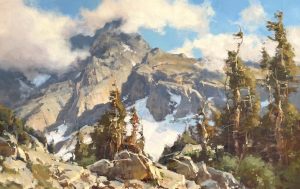
Scott Christensen, High in the Wind River Mountains | Oil on Canvas | 26 x 40 inches
Christensen, however, keeps returning to the places that have meant the most to him during his lifetime. “They are places I love, places that have the most memories for me,” he says. “I do hundreds of gouaches and studies outdoors, and they really are about the places I want to be. That experience, what I feel when I’m out there, is what this show is all about. I learn so much every time I’m painting, and my goal is to become an artist rather than just represent something. I want to find what it is that pulls at my emotions while I’m experiencing these landscapes.”
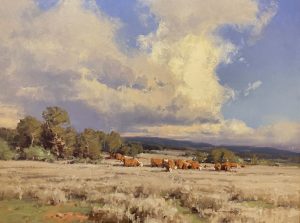
Scott Christensen, Wyoming | Oil on Canvas | 30 x 40 inches
Ho, on the other hand, sees subject matter as secondary to the paint itself. He finds all the drama he needs right on the canvas, not in the physical realm. “I can find visual excitement all around me — from a knot on a tree and the graceful limp of a flower wilting to the juxtaposition of a few simple shapes and colors. Inspirations are inexhaustible,” said Ho in the exhibit catalogue for East/West Visions. “The real essence of painting is the dialogue between shapes, tones, colors, textures, edges, and lines. Everything else follows, including light, form, concepts, personal beliefs, and inspirations. With every painting, there is a singular visual thought to be completed.”
For Ho, this is “painting without a style,” painting for the love of the process, for the love of the paint itself. “One day, I may be interested in a color statement, and the next, it may be a relationship of simple shapes,” he says. “I’m more interested in representing the mundane details of my immediate environment than in searching the world for preconceived artistic content.”

Scott Christensen, March Snowpack | Oil on Canvas | 40 x 48 inches
Ho sees his art as an attempt to paint light as it moves through a composition. “It is about painting that passage of light as it washes everything in the composition and the idea that what light doesn’t touch is shadow. It sounds simple, but it’s amazing how many paintings are unsuccessful because of the lack of understanding and awareness of this process.”
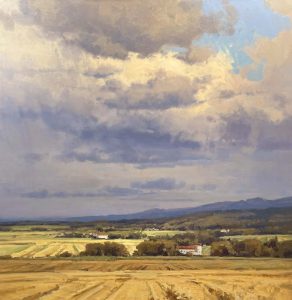
Scott Christensen, August Tucson Valley | Oil on Canvas | 48 x 48 inches
The July exhibition at the Museum of Western Art marks an important moment for both artists in their careers, including being Christensen’s largest exhibition to date. Beauchamp also believes that this will be one of the most important shows the museum has ever curated. “Whether you’re a serious art collector or someone who appreciates the artistry of a master, this is one exhibition you won’t want to miss.”





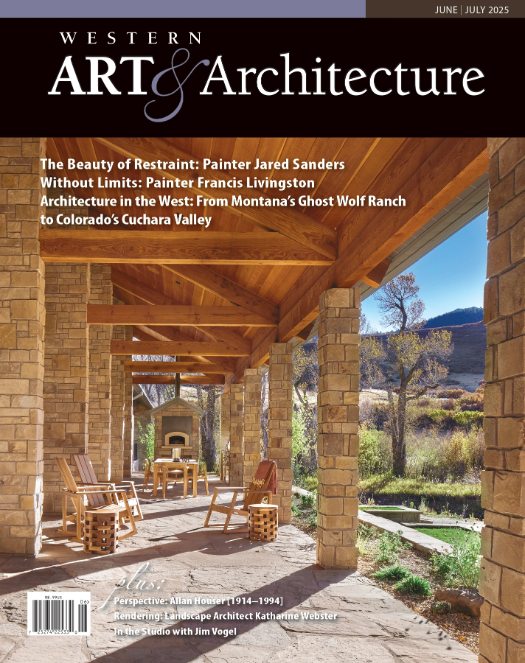
No Comments